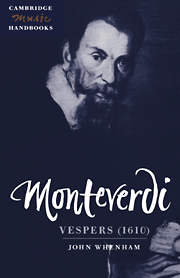Book contents
- Frontmatter
- Contents
- Acknowledgements
- List of abbreviations
- 1 Introduction
- 2 The 1610 settings and the liturgy of Vespers
- 3 The 1610 print and Monteverdi's career
- 4 ‘Suited to the chapels or chambers of princes’
- 5 ‘And all on a cantus firmus’
- 6 Issues of performance
- Appendices
- Notes
- Select bibliography
- Discography
- Index
1 - Introduction
Published online by Cambridge University Press: 12 January 2010
- Frontmatter
- Contents
- Acknowledgements
- List of abbreviations
- 1 Introduction
- 2 The 1610 settings and the liturgy of Vespers
- 3 The 1610 print and Monteverdi's career
- 4 ‘Suited to the chapels or chambers of princes’
- 5 ‘And all on a cantus firmus’
- 6 Issues of performance
- Appendices
- Notes
- Select bibliography
- Discography
- Index
Summary
With its mixture of the splendid and the intimate, the sensual and the sublime, the music of Monteverdi's Vespro della Beata Vergine (Vespers of the Blessed Virgin), often called the ‘1610 Vespers’ for short, has gained widespread and enduring popularity. It was published, together with a Mass setting, in the Missa … ac Vespera … cum nonnullis sacris concentibus {Mass and Vespers, with some Sacred Concertos), which Monteverdi issued at Venice in 1610 (publication at Venice signifies not that it was a Venetian work, but that Venice was the main centre of music publishing in early seventeenth-century Italy). Like most late Renaissance publications of church music, this was a volume intended to serve a number of purposes. At one level, of course, it was a vanity publication, a portfolio of the composer's work gathered together for the world to admire, and the unprecedented way in which Monteverdi set out his Vespers music in the volume – as a set of music for Vespers of the Madonna interspersed with motets and the ‘Sonata sopra Sancta Maria’ – may have owed something to a wish to make the best possible show with a relatively small collection of settings. At another level, however, it was intended as a resource book for choirmasters, who would have used as many or as few of the settings as they required or their singers could manage.
- Type
- Chapter
- Information
- Monteverdi: Vespers (1610) , pp. 1 - 5Publisher: Cambridge University PressPrint publication year: 1997



